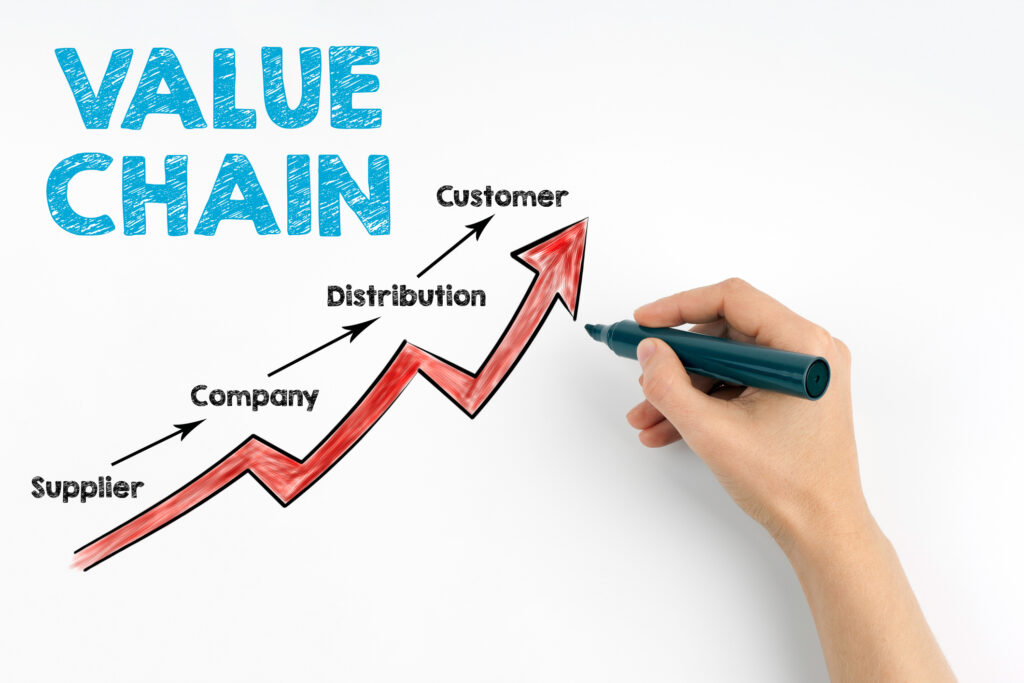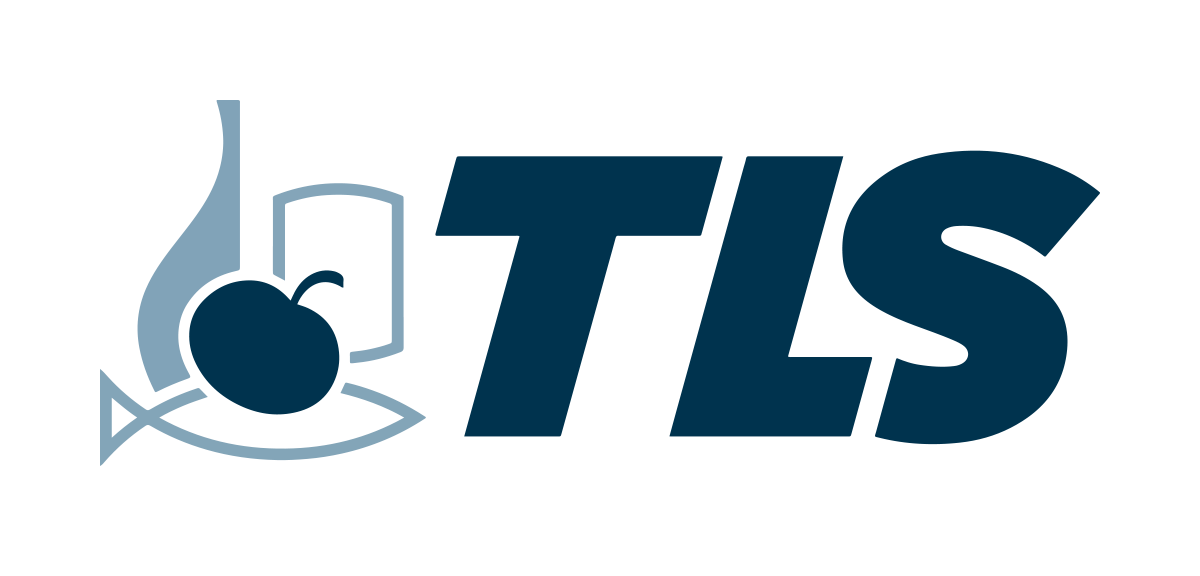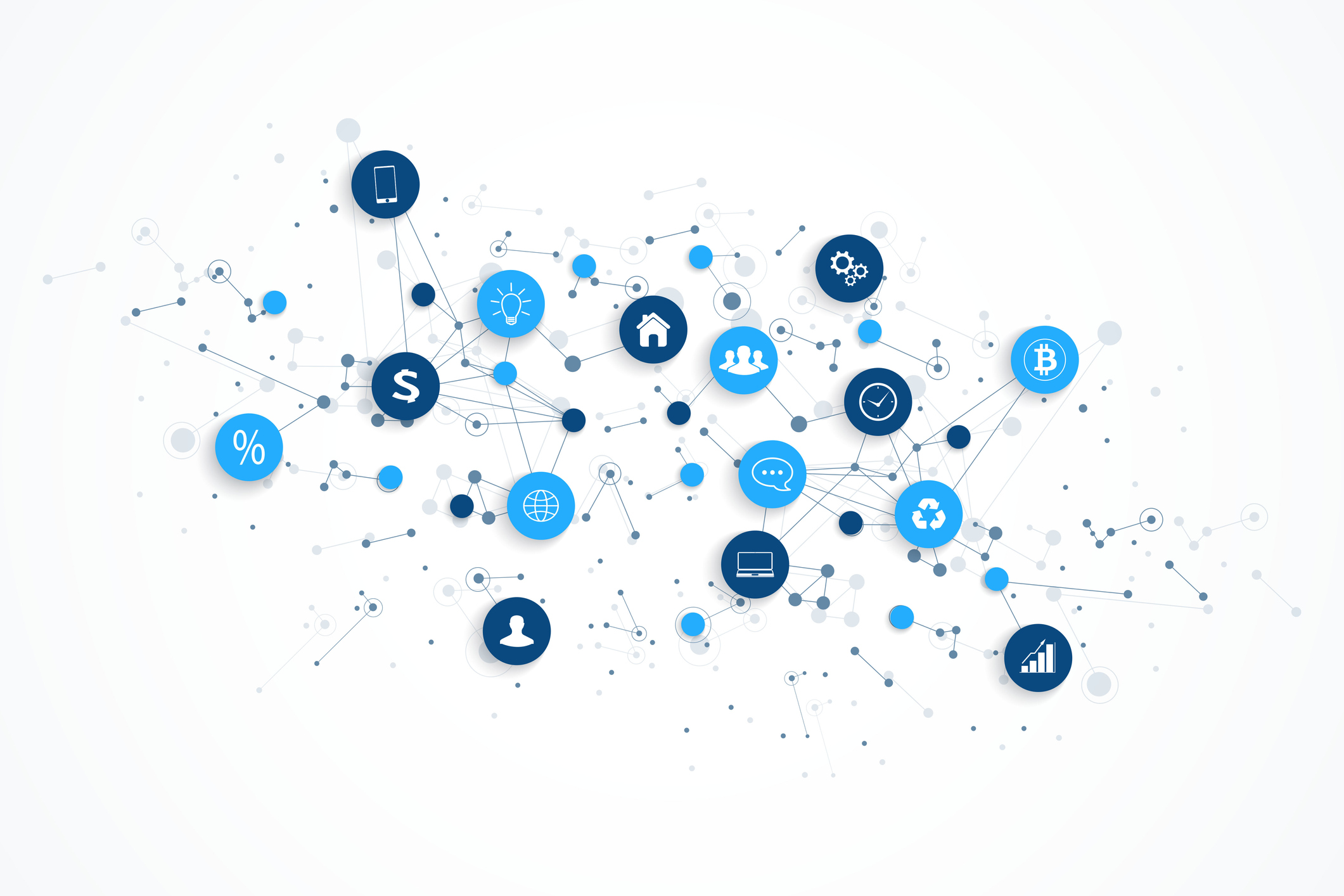Understanding the nuances of critical business processes is key when you’re competing with a whole host of competitors for market share. Why? Because this understanding of key business concepts forms the bedrock of creating the operational strategies that make a company both operationally efficient and profitable. One of these important concepts is the value chain vs supply chain.
While these two terms may seem similar, what they mean, what they’re made up of and how they’re applied are entirely unique and different. Simply put, the value chain refers to the activities involved in creating a product or service and delivering it to consumers, while the supply chain refers to the actual network of producers, partners and suppliers that produce and distribute a company’s product or service. But of course, there’s more to it than just that.
In this article, we take a deeper look into these two concepts, identifying their respective roles in the Consumer Packaged Goods (CPG) and e-commerce industries and exploring their differences.
Learn why Thomas, Large & Singer has been a trusted CPG value chain partner for over a century.
What is a Value Chain?
A value chain is the structured view of all the activities required to deliver a product or service to the market. It maps and examines each process within a company, from where they get their raw materials all the way to how they deliver their final product to customers, highlighting where value is added at each step.
The value chain concept underscores the reality that a company is more than a random concoction of machinery, people, and money. It is a dynamic system where inputs are transformed into outputs that customers are willing to pay for, creating the need for a competitive advantage and outstanding customer value to stand out.

Components of a Value Chain
Primary Activities
The primary activities of a value chain directly contribute to the production, sale, management, maintenance, and support of a product or service. They include:
- Inbound Logistics: These are the processes involved in receiving, storing, and distributing the raw materials used in production.
- Operations: This encompasses the methods and procedures used to take those raw materials and transform them into the final product.
- Outbound Logistics: These activities involve storing and distributing the finished product to the customer.
- Financial Management: This area is concerned with all of the order-to-cash activities and back-end administrative work.
- Marketing and Sales: This area is concerned with marketing strategies that promote the brand, attract customers and drive sales.
- Service: These activities maintain and enhance the product’s value after it has been purchased, such as customer support and after-sales service.
Knowing that these primary activities contribute to the success of a CPG brand is why Thomas, Large & Singer has been delivering customized value chain solutions for over a century. Our targeted strategies are designed to streamline your inbound logistics, operational processes, outbound logistics, and financial management activities for superior efficiency and effectiveness.
Support Activities
In addition to the primary activities, there are also support activities that further boost the value created by the primary processes. They include:
- Procurement: This involves the acquisition of resources necessary for the operations of the company.
- Technology Development: This includes all activities related to managing and processing information, as well as protecting a company’s unique knowledge base.
- Human Resource Management: This involves hiring, training, and retention of employees.
- Infrastructure: This encompasses company systems for planning, finance, quality control and general management.
As you can tell, there’s quite a bit that goes into making a value chain efficient and effective, and conducting a value chain analysis allows companies to assess what’s working, what’s not and what can be further improved.
Discover more about value chain analysis with our helpful guide.
So, what is the role of a Value Chain in e-commerce and CPG industries?
In the CPG industry and e-commerce, the value chain is particularly important. The reason? These sectors deal with a tough combination of highly competitive markets, tight profit margins, and discerning customers who have more than enough options at their fingertips. This dynamic environment demands a deep understanding of the value chain vs supply chain to maximize customer value and establish an edge over the competition.
The primary and support activities of the value chain can help CPG companies and e-commerce platforms identify areas where they can minimize costs, improve product quality, innovate faster, and ultimately provide a superior customer experience that outdoes their direct competitors. In essence, it helps in creating strategies that offer customers better value, be it through high-quality products, lower prices, faster delivery, or outstanding after-sales service.
What is a Supply Chain?
Now that we’ve addressed the basics of what makes up the value chain and its role in the CPG and e-commerce industries, let’s dive into its important counterpart – the supply chain.
A supply chain refers to a network between a company and its suppliers that produce and distribute a specific product or service. The supply chain encompasses every stage of production, from the initial sourcing of materials to the final delivery of the product to consumers.
The supply chain’s purpose is to ensure that a company can transform raw materials into finished products efficiently and cost-effectively. It also ensures that the product is available at the right time and place to meet customer demand, something that isn’t always easy to predict.

Components of a Supply Chain
The main components of a supply chain can be broken down into three categories:
1. Sourcing
Sourcing involves identifying, evaluating, and procuring the raw materials or services needed to produce goods. This step also includes the management of supplier relationships to ensure a steady, reliable flow of quality inputs.
2. Production
Production includes all the activities that turn raw materials into finished goods. This might encompass design, manufacturing, packaging, and quality control. A well-managed production process ensures that products are of high quality, produced cost-effectively, and meet market demand.
3. Distribution
The final key component of the supply chain is distribution, which includes storing, managing inventory, and transporting the finished product to the customer. This process needs to be efficient and reliable to meet customer expectations for delivery speed and order accuracy.
What is the role of a Supply Chain in e-commerce and CPG industries?
In the e-commerce and CPG sectors, the supply chain is the backbone of operations. It directly impacts a business’s ability to meet customer demands, maintain consistent quality, and maintain profits.
Effective supply chain management in these sectors is crucial since it directly affects time to market, product availability, and the ability to adapt to market changes. It’s about getting the right product, in the right quantity, at the right place, at the right time, and at the right cost. The supply chain can also significantly influence customer perceptions of a brand, affecting their trust and willingness to buy again.
Key Differences Between Value Chain vs Supply Chain
Scope and Focus
The main difference between a value chain vs supply chain lies in their scope and focus. A value chain is a broader concept that looks at every internal activity a business engages in while delivering a product or service. It is focused on creating value for the customer at every step and improving the company’s competitive position.
On the other hand, a supply chain has a narrower focus and is really a component of the broader value chain. It specifically looks at how a product is created and delivered, from sourcing to production to distribution. When it comes to supply chains, the need is, ultimately, to have stability and reliability.
Activities Involved
In terms of activities involved, the value chain includes both primary and support activities within an organization. It encapsulates everything from inbound logistics, operations, and outbound logistics to financial management, marketing, sales, and service.
The supply chain concentrates on the flow of goods and services, encompassing sourcing, production, and distribution processes. It’s concerned with how raw materials are acquired, transformed, and delivered to the end customer.
End Goals
The end goals of the value chain vs supply chain are also different. The ultimate objective of a value chain is to maximize the value delivered to customers, thus gaining a competitive advantage for the business over its competitors.
Conversely, the primary goal of a supply chain is to deliver the right product, in the right quantity, to the right place, at the right time, and at the right cost, aiming for peak operational efficiency and unparalleled customer satisfaction.
Use of Technology and Data Analytics
Technology and data analytics play a vital role in both value and supply chains, but they are applied differently.
In the value chain, technology can be used to enhance each activity, from improving inbound logistics to refining after-sales service. Data analytics can reveal opportunities to reduce costs, improve product quality, or even speed up delivery times.
Within the supply chain, technology is typically used to streamline and automate sourcing, production, and distribution processes. Data analytics can help improve supplier selection, predict demand more accurately, and optimize inventory management.
How TLS leverages technology as part of our logistics solutions.
The Importance of Understanding the Difference Between Value Chain vs Supply Chain
So why does knowing all these differences matter? Because understanding the distinctions between the value chain vs supply chain can lead to multiple business benefits.
Improved Operational Efficiency
By understanding the specific processes involved in the value chain vs supply chain, businesses can identify areas that are inefficient or ineffective, and that can be improved or removed. This knowledge of both concepts enables more informed decisions, leading to streamlined processes, cost reductions, and, ultimately, improved operational efficiency.
Enhanced Customer Experience
Both chains significantly impact the customer experience, which is really the top concern of all businesses that put out a product or service. The value chain focuses on providing maximum value to the customer at each stage of the product journey, while the supply chain ensures that the product is delivered effectively and efficiently. Understanding these aspects can help businesses enhance their customer experience, build lasting relationships and boost brand loyalty.
Increased Profitability
When a company can deliver high-quality products quickly, efficiently, and at a lower cost, it results in higher customer satisfaction and repurchases, driving sales and increasing profitability. The dual insights from both value and supply chain analysis can help businesses in achieving this balance.
Better Decision-Making and Strategic Planning
The ability to distinguish between the value chain vs supply chain allows businesses to make more informed strategic decisions. Taking a comprehensive view of all processes, from product conceptualization to delivery, and knowing where they fall within either the value chain or supply chain equips businesses with the insights needed to plan strategically.
How Thomas, Large & Singer Leverages Both Value Chain and Supply Chain Management
Here at Thomas, Large & Singer (TLS), we leverage both value chain and supply chain management to drive efficiencies, effectively reach North American consumers and help deliver superior customer value.
A 360-degree Suite of Tailored CPG Solutions
With a deep understanding of the CPG industry’s value and supply chains, we provide complete and tailored solutions to address unique challenges for clients accessing the U.S. and Canadian markets, including:
- In-depth brand, market, financial and logistics analysis
- Product development and management
- Access to our established distribution network throughout North America
Our offerings range from data management, analytics, and supply chain solutions to sales representation and e-commerce solutions. We work closely with our partners to understand their specific needs and develop unique strategies that optimize both their value and supply chains.
Partnerships with Distributors, Food Processors, and National Account Operators
We believe in the power of collaboration. Our partnerships with distributors, food processors, and national account operators in the U.S. and Canada enable us to leverage a broad and robust supply chain. This collaboration ensures that we help clients deliver the right products at the right time and at the best price.
Innovating and Shaping the E-commerce Industry and CPG Supply Chains
TLS is a pioneer in the use of data analytics and technology in the CPG industry. We harness these tools to optimize our partners’ value and supply chains and provide customized reports, driving efficiency, improving product delivery, and enhancing customer value.
Partner with TLS Today
In an increasingly competitive market, understanding and leveraging the value and supply chains can make the difference between success and failure. By partnering with TLS, you gain access to our extensive industry knowledge, innovative solutions, and robust networks, equipping you to make the most of both your value and supply chains.
Call us at 1-800-268-5542 or submit a quick contact form to learn more about how we can help you optimize your operations, deliver superior customer value, and achieve your business goals.
FAQs
Is value chain another name for supply chain?
No, the value chain and supply chain are not the same. While both concepts deal with business processes, they have distinct focuses and components. The value chain is an analytical framework that looks at all the activities involved in delivering a product or service to the market, highlighting where value is added at each step. On the other hand, the supply chain refers to the network between a company and its suppliers that produce and distribute a specific product, from the sourcing of raw materials to the final delivery to the customer.
What is an example of a value chain?
Let’s take an example from the tech industry. Apple’s value chain involves various primary and support activities:
- Inbound Logistics: Apple acquires components from various suppliers worldwide.
- Operations: These components are then assembled to create Apple products, like iPhones and MacBooks, at their facilities.
- Outbound Logistics: Apple products are then distributed to retail stores across the globe.
- Financial Management: This involves Apple’s strategic allocation of resources for research and development, rigorous budgeting for its global marketing campaigns, and prudent investment decisions that enable the company to maintain its innovative edge while also driving profitability.
- Marketing and Sales: Apple invests heavily in marketing and advertising to create a unique brand identity and generate consumer demand.
- Service: Apple provides after-sales services like Apple Care and tech support to enhance the customer experience.
Support activities include human resources (hiring and training employees), technology development (research and development), infrastructure (management and finance), and procurement (acquiring resources).
How does a supply chain differ from a value chain?
The supply chain and the value chain are different in terms of their scope, focus, activities involved, and end goals.
Scope and Focus: A value chain focuses on the complete range of activities involved in delivering a product or service to the market, aiming to create maximum value at each step. In contrast, a supply chain focuses on the processes involved in creating and delivering a product, aiming for operational efficiency and customer satisfaction.
Activities Involved: The value chain includes both primary and support activities, encompassing everything from raw material acquisition to customer service. The supply chain, however, focuses solely on sourcing, producing, and distributing the product.
End Goals: The goal of a value chain is to maximize value delivered to customers and gain a competitive advantage, while the goal of a supply chain is to deliver the product effectively and efficiently, striving for cost-effectiveness and customer satisfaction.
What is the value chain in supply chain strategy?
The value chain plays an integral role in the supply chain strategy. A comprehensive supply chain strategy not only focuses on cost-efficiency and timely delivery of products but also aims to add value to the customer at each stage.
The value chain perspective can help identify areas where value can be added, such as improving product quality, enhancing customer service, or innovating in product design. This integrative approach ensures that the supply chain is not only efficient but also competitive, enhancing customer satisfaction and business profitability.
Is the value chain broader than the supply chain?
Yes, the value chain is broader than the supply chain. The value chain encompasses all activities a company undertakes, from raw material acquisition to after-sales service. This includes supply chain activities, but it also goes beyond them to include areas such as marketing, sales, and customer service, which are not traditionally considered part of the supply chain. So, the value chain provides a more comprehensive view of the business operations than the supply chain.
Is a supply chain more inclusive than a value chain?
No, a supply chain is not more inclusive than a value chain. The supply chain is, in fact, a part of the broader value chain. It primarily focuses on sourcing, production, and distribution processes, ensuring that raw materials are transformed into final products and delivered to customers efficiently.
On the other hand, a value chain includes not only these supply chain activities but also other functions such as marketing, sales, and customer service. Therefore, the value chain provides a more inclusive and holistic view of a company’s activities.
Have more questions? Don’t hesitate to give us a call at 1-800-268-5542 or submit a contact form. We’d be happy to provide more information and discuss your needs!


